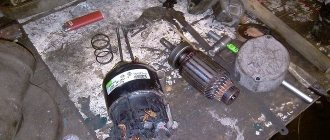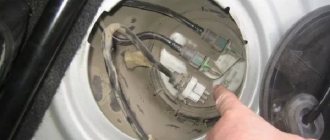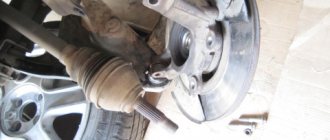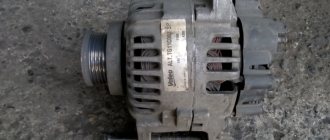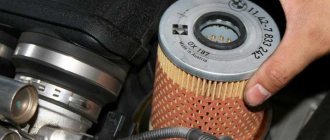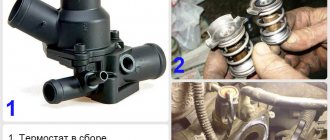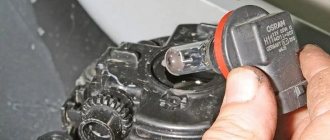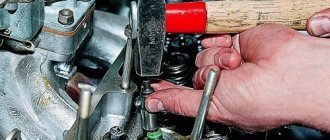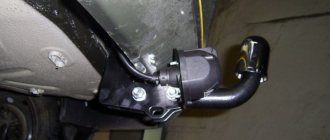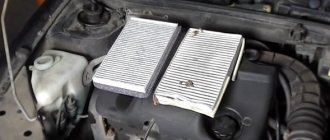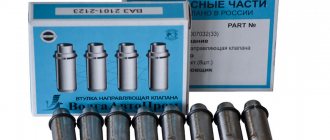Replacing the phase regulator of Renault Megane 2 with F4P
Depending on the crankshaft speed and throttle opening, the behavior of the mixture entering the cylinder and the exhaust gas output change greatly.
Adjustable phases make adjustments taking into account changes in the crankshaft speed and the degree of filling of the fuel-air mixture. The phase regulator provides advantages:
- Reducing CO2 emissions.
- Increased torque in all ranges of engine operation.
- Increased power output.
- Fuel economy.
- Reduced noise and vibration during engine operation.
Principle of operation:
The Renault F4P engine is equipped with one phase regulator installed in the intake shaft pulley. Oil is supplied to the phase regulator through an electromagnetic valve mounted on the cylinder head cover. Valve location in the figure.
A signal is sent to the valve to open and supply oil to the channel, which allows you to adjust the valve timing. The electronic control unit (ECU) sends a signal to the degree of valve opening. The degree of opening is proportional to the required phase shift.
Oil enters through the central hole of the impeller and the holes for lifting the plunger. Under pressure, the plunger moves down and releases the impeller; under the influence of oil pressure, the blades of the impeller and phase regulator rotate towards the delayed closing of the intake valves.
In the absence of an incoming signal to the solenoid valve from the computer, the impeller blades return to their original position under the influence of engine rotation, the plunger blocks the entire system in the position of minimal delay in the opening of the intake valves.
On cars with an F4P engine model, the phase regulator operates subject to several conditions:
- Speeds above 1500 rpm.
- The pressure in the inlet pipe is above 500 bar.
- The coolant temperature is above 30 degrees.
Many manufacturers use this system on cars. These include Opel, Renault, Nissan and others. Such systems are installed on both gasoline and diesel engines. On the latter, the system is used to reduce vibration and noise at all speeds.
The main signs of phase regulator failure:
- difficult engine starting;
- extraneous noise when the engine is running;
- increased fuel consumption;
- reduction in engine response.
If a metallic crackle is heard when starting the engine when cold, then the valve does not have time to pump oil into the phase regulator.
When starting, the engine runs for a while, then stalls. The symptom is associated with a clogged mesh in the solenoid valve. At SANRENO, mechanics will be able to check for contamination in the valve screen and, if necessary, make a recommendation for cleaning. Cost - 420 rubles.
If the phase regulator malfunctions, “Engine error” appears. To decipher it, you need a special device. Reading engine errors costs 700 rubles.
Reasons for phase regulator failure:
- Oil starvation. It occurs either due to insufficient level or due to a clogged mesh of the solenoid valve, which regulates the quantity and pressure. The technicians will check the level and, if necessary, offer to top it up. The cost of 1 liter of oil recommended by Renault is 350 rubles.
- Using oil with characteristics different from those required in the engine specifications. It is necessary to use what is recommended by the manufacturer, taking into account climatic conditions.
- Untimely replacement of engine oil. This leads to an increase in deposits in the oil channels and on the solenoid valve mesh, which leads to starvation of the phase regulator and its rapid failure.
Operating principle of the phase regulator
To understand why the phase regulator cracks or its valve jams, it makes sense to understand the principle of operation of the entire system. This will give a better understanding of breakdowns and further actions to repair them.
The engine does not perform the same at different speeds. Idle and low speeds are characterized by so-called “narrow phases”, in which the exhaust gas removal rate is low. Conversely, high speeds are characterized by “wide phases”, when the volume of gases released is large. If “wide phases” are used at low speeds, then the exhaust gases will mix with the newly incoming ones, which will lead to a decrease in engine power, and even stop it. And when “narrow phases” turn on at high speeds, it will lead to a decrease in engine power and its operating dynamics.
There are several types of phase control systems. VVT (Variable Valve Timing), developed by Volkswagen, CVVT - used by Kia and Hyindai, VVT-i - used by Toyota and VTC - installed on Honda engines, VCP - Renault phase regulators, Vanos / Double Vanos - system used in BMW. Next, we will consider the principle of operation of the phase regulator using the example of a Renault Megane 2 car with a 16-valve K4M engine, since its failure is a “childhood disease” of this car and its owners most often encounter a non-working phase regulator.
Control occurs through a solenoid valve, the oil supply to which is regulated by electronic signals with a discrete frequency of 0 or 250 Hz. This entire process is controlled by an electronic control unit based on signals received from engine sensors. The phase regulator is switched on when the engine load increases (rpm value from 1500 to 4300 rpm) when the following conditions are met:
- serviceable crankshaft position sensors (DPKV) and camshaft position sensors (DPRV);
- there are no malfunctions in the fuel injection system;
- the phase injection threshold value is observed;
- the coolant temperature is within +10°…+120°С;
- increased engine oil temperature.
The phase regulator returns to its original position when the speed decreases under the same conditions, but with the difference that zero phase shift is calculated. In this case, the locking plunger blocks the mechanism. Thus, the “culprits” for a malfunction of the phase regulator can be not only the phase regulator itself, but also the solenoid valve, engine sensors, malfunctions in the motor, and malfunctions of the ECU.
The picture shows a comparison of used oil and new oil.
If these symptoms occur during operation of the vehicle or an engine error occurs, immediately contact the service center for further diagnosis and troubleshooting.
The photo shows a phase regulator with wear. Failure due to untimely oil change.
Replacing the phase regulator is a labor-intensive process, it includes removing the drive belt and timing belt. The replacement will cost 3,920 rubles (this amount includes the removal and installation of the timing belt and drive belt for additional units, and replacement of the phase regulator). The cost of a new phase regulator is 10,950 rubles.
It is necessary to check and, if necessary, change the timing belt. The cost of the work is included in the replacement of the phase regulator. The cost of a new original timing kit is 6,000 rubles. Additionally, when replacing the timing belt, new camshaft plugs are used. The cost of a set of plugs is 700 rubles.
In our service center, the technician will definitely check the condition of the water pump for leaks, bearing noise and play. If necessary, he will make a recommendation for its replacement. The cost of work with the timing belt removed is 700 rubles. The cost of a new pump is 2600 rubles.
The technicians will check the camshaft seals and the front crankshaft seal for oil leaks and, if necessary, give recommendations for replacing them. The cost of replacing oil seals with the timing belt removed:
- front crankshaft oil seal 350 rubles;
- camshaft seals 350 rubles each.
Also, when replacing the phase regulator, our service center will definitely check the solenoid valve, which is responsible for the oil supply. They will check its performance and the presence of deposits. If necessary, they will give recommendations for replacing this part. The cost of the work is 350 rubles. The cost of a new valve is 6980 rubles.
Renault Megane Silver Bullet › Logbook › Extraordinary replacement of the timing belt, oil seals and phase regulator.
Hi all! ))) Not much time has passed since the last replacement of the timing belt, phase regulator and related ones. Or rather, almost 3 years and 35,273 kilometers. ))) And now, again replacing the belt and phase regulator. The fact is that the original oil seals began to snot after 10-15 thousand. The phase regulator began to crackle after about the same time (more on that later). In general, everything needed to be replaced.
Since the timing belt does not like oil, it was decided to take our own money and go to a service center. I did not go to Alexey (in Solnechny), to whom I usually turned with similar questions. This time, on the advice of several friends from Saratov_Megane_Crew
, I turned to
Alexander
, who once worked for an official Renault dealer. The reviews about him were only positive, so I called him in advance, got advice on which seals were best to buy so that this wouldn’t happen again, and found out about the cost of the work. The next stage was the purchase of spare parts:
On 05/17/2018 I went to Alexander to have everything described above replaced. )) After removing the timing cover, I concluded that we had not gone there in vain. Everything was covered in oil.
After removing the belt, add. equipment, it became clear that its tension roller also needs to be replaced:
We took advantage of what was available in the nearest store, namely, a roller from a GAZelle, Euro-3, reinforced. )))
While the throttle was removed I cleaned it up a bit. )))
The tensioner and idler rollers of the timing belt were also in disrepair.
The timing belt was not as heavily stained with oil as I expected, but it was clear that it had absorbed enough of it.
Then everything was washed, degreased and changed...
Extra belt I decided to keep the old equipment. For 35,000 it was almost unscathed. ))
For all the work done, namely: replacing 4 oil seals, replacing the timing belt and phase regulator, Alexander charged me only 2,500 rubles.
Now about the old phase regulator. why did it crackle after only 10-15 thousand? Here I have 2 options. The first is a tired phase regulator valve, which completely broke down last year and was replaced with a valve from Ali, but it had already damaged the phase regulator. The second option is that Alexey simply did not change it for me. I understand everything, people need to be trusted and all that... But after the last replacement, I did not feel any changes in the behavior of the car, absolutely. This time the craving appeared, the failures went away. My Megan didn’t become an RS, of course, but he drives. True, error DF080 still pops up periodically. I will look for the reason. )))
Repair of phase regulator Renault Megane 2
There are a lot of doubts about replacing the phase regulator gear yourself; it is believed that only professionals can do this. But with certain skills, you can make repairs and replacements yourself.
To repair the Renault Megane 2 phase regulator we will need a standard set of tools, 16 and 18 mm wrenches, a torque wrench and 6 and 14 mm hexagons.
As practice shows, repairs to the Renault Megane 2 phase regulator can be done personally. The most important thing for a reliable fit of the gear shafts is to scrupulously degrease the seats and the shafts themselves.
Replacement procedure
1. Remove the crankcase protection. We place a reliable jack directly under the crankcase through a fairly strong board. Raise the engine a little.
2. Remove the decorative panel, motor mount, and resonator.
3. From the bottom right, remove the plastic engine mudguard and the acoustic rod.
4. Remove the camshaft plugs.
5. Unscrew the plug from the block using a special head.
6. Twist the crankshaft bolt until the slots in the camshafts are almost horizontal.
7. Insert a suitable bit into the hole in the block, tightening the crankshaft slightly. The beard must go deep into the crankshaft and securely lock it; in this case, the special slots of the camshafts must become horizontal.
8. Remove the poly V-belt. Unscrew the crankshaft pulley bolt and carefully remove the pulley.
9. Unscrew the inconveniently placed 6 mm bolt and remove the special plastic protection on the timing belt. We remove the belt itself.
10. Remove the idler pulley and timing belt tensioner. It is not recommended to install an old belt.
11. If necessary, you can drain the antifreeze from the lower pipe and change the “pump”.
12. Unscrew the plug on the phase regulator with a special 14mm hexagon. Then, using a 16 mm wrench, unscrew the bolt securing the regulator itself, having first secured it with a screwdriver.
13. We change all the seals.
14. Degrease all gear seats. We install the new phase regulator gear and tighten it with a new bolt.
15. Everything is assembled in the opposite order.
Renault Laguna II. Replacing the phase regulator
Much has been said and written about replacing the phase regulator. There are many doubts about replacing the timing belt yourself, and changing the phase regulator gear is considered possible only by officials. What's so scary about it? If the timing belt can be changed independently, then why is the phase regulator so scary?
For repairs, you will need a standard set of tools, 16 and 18 mm spanners, 6 and 14 mm hexagons, and a torque wrench.
As practice shows, there are no marks anywhere, all pulleys do not have keys. However, the rear ends of the camshafts, which are capped, have slots that are slightly off-center, and there is a hole in the crankshaft balancer to fix TDC. It's enough. For a strong fit of all gear shafts, it is necessary to thoroughly degrease the shafts and seats themselves.
ATTENTION! THE MATERIAL PROVIDED BELOW IS PROVIDED WITHOUT WARRANTY OF ANY KIND. YOU ARE RESPONSIBLE FOR ALL CONSEQUENCES OF INDEPENDENT REPAIR! IT IS RECOMMENDED TO USE THE SERVICES OF A SERVICE STATION.
Phase regulator for Renault Megane 2
Adjustment of engine operating modes is carried out using a phase regulator through the oil valve sensor. This component fails over time. How can I identify the problem and solve the problem myself? This content will provide a clear explanation on all issues in this area. We will try to understand how to replace the phase regulator directly with our own hands.
How to repair RFG with your own hands
How to restore and replace the phase regulator directly with your own hands can be found on various video resources. However, textual content can also reveal the issue with no less detail, which will help identify the sources of the problem, as well as troubleshoot the operation of the phase regulator using improvised means.
One of the reasons is a worn-out valve for shutting off the oil or the RFG oil seal on Renault Megane 2. This idea is suggested by the formation of leaks near the indicator and oil seal, which are clearly visible on videos on this topic. Therefore, you should contact the auto store to purchase the part marked 8200823650.
The decorative insert on the Renault Megane 2 engine is first removed using a standard hexagon. This step begins the valve replacement procedure. Then the valve sensor contact is disconnected. The removed wire assembly is placed to the side.
Afterwards, the end side of the phase control valve is found, which is fixed with a bolt with a diameter of 10, and it is unscrewed. By removing the valve, you can determine the need for repair. This will be indicated by cracks in the housing, corrosion of the RFG connecting terminals, as well as other physical defects that indicate that the unit will soon fail and a new one is needed. You can’t ignore the oil seal, which is a rubberized sealing ring. It is also advisable to replace it.
Usually the oil seal is replaced with a new one. The used sealant must first be removed using a hook or knitting needle. The feasibility of changing it is visually determined. After which, using a wooden block or tube, it is returned to its original place by pressing. The video just shows the second option. Installation of the new RFG valve on the Renault Megane 2 is performed in the reverse order. The part is returned to its place, the bolt is clamped, and the contact from the phase regulator is connected to the standard connection. This is exactly how the phase regulator is replaced.
Megan_2 does not find the starting point with the phase regulator.
#1 STimon
Attention! I'm just the owner of an old car!
- Users
- 6 messages
- City: Ryazan region.
- Gender: Man
I would be very grateful for the KV+RV oscillogram for Megan_2 2005, 1.6 liters, 16 valve, Sagem S3000 block. I can’t find the reason for the errors in setting the initial position of the phase regulator. The positions of the RF and CV are according to the templates, the valve and sensor of the RF are working, clean, when voltage is applied to the XX voltage to the phase regulator control valve, the machine stalls, i.e. The FR itself works. Despite all this, he cannot find the starting position! Suspicion of a glitch in the ECU.
What leads to this idea is that the numbers that should be on the measurement channels of the position of the PV are not fully recorded and the position of the PV reads 52-53 degrees, instead of the required 20. There was a suspicion that the target of the PV sensor was rotated. I found one oscillogram on the Internet (and many links to the same one) that seems to correspond to what I have, but suddenly. This is the idea I would like to test with your help. I’ll post photos of the oscillograms a little later, they’re at home.
Best regards, Dmitry.
PS: I thought the settings file was a biscuit, I want to try to compare it with a similar one, maybe someone has a damos for this block? Or at least addressing, where the control and calculation of the phase regulator is prescribed.
- Top
- Nickname or quote
#2 Sasha
- City: Ch.Gat
- Gender: Man
So you will post a few dumps, perhaps it will not be a stock.
Before ordering modified software, carefully read the RULES
Attention! I don't work with car owners! I do not work with firmware “readers and uploaders”!
For work issues, available from 8.00 to 17.00 Moscow time . Requests received after this time will be reviewed the next day. Attention! Ordering the missing modified software in the APC Client database is available from your personal account on the store website.
- Top
- Nickname or quote
How to install a new RFG mechanism
A separate story is the work not only on monitoring the condition of the phase regulator oil seal, but also the procedure for installing the new RFG mechanism on the Renault Megane 2. This aspect is quite well discussed in various thematic video reviews. Such a process requires high qualifications, so you should contact a car service to perform it.
If there is no specialized organization that can carry out high-quality work, you can do the repair of Renault Megane 2 yourself. However, it is necessary to carefully approach the issue of studying the video in this direction and follow the order of work when replacing the phase regulator.
First, the oil seal is removed as indicated above. The Renault Megane 2 engine is jacked up using a special “claw” or an identical object. Afterwards, the engine stops at the coincidence of the camshaft and crankshaft marks. The rollers and timing belt drive are dismantled. Afterwards, the fasteners are unscrewed and the phase regulator is removed.
How to change the mechanism?
Of particular interest is not only checking the phase regulator seal, but the process of replacing the phase regulator mechanism itself, which is widely presented in thematic videos. This process is the most difficult, so it is best to entrust the work to a qualified craftsman.
If there is no opportunity to contact the service or you want to work independently, you need to be extremely careful and attentive when working, and also study videos on the relevant topic.
The first step is to remove the oil seal, as described in the first part of the article. Then Megan's engine is raised on a support, using a specially designed “claw” or any other suitable object for this purpose. Then the positions of the camshaft and crankshaft are fixed with marks, the timing belt and rollers are removed. After this, the fastenings of the phase distributor are unscrewed and it is removed.
The process of replacing the phase regulator Renault Megane 2:
- The engine rises slightly
- The decorative panel, resonator and engine mount are removed
- At the bottom right is the engine mudguard and acoustic thrust
- The camshaft plugs are removed
- The slots are aligned according to the marks on the camshafts and fixed in this position.
- The crankshaft is fixed through a hole in the block and the crankshaft pulley is released
- The protective casing is released and the timing belt is removed.
- The tensioner and idler pulley are released
- The plug on the phase regulator is unscrewed and the bolts securing it are released
- Oil seals are replaced
- The Renault phase regulator is being replaced with a new one
- Everything is put back together in reverse order
At these stages of work, it is recommended to change all oil seals, the timing belt, and check the condition of the pump. When reassembling, it is necessary to install new gaskets, a new phase regulator gear, and timing belt rollers.
The work of replacing the Renault Megane 2 phase regulator is very important; it requires precise installation of components and materials, correct tightening force, as well as the presence of special devices.
Sign up by phone. 8(495)94-067-94 to the specialized auto repair center Megan Repair, we will provide a professional replacement of the Renault phase regulator, and also provide a guarantee on work and spare parts.
Renault phase control valve
The solenoid valve that controls the operation of the phase regulator can cause uneven operation of the engine at idle and negatively affect the dynamics of the car and fuel consumption. Today we will look at why this happens and talk about troubleshooting problems that arise due to malfunction of the phase shifter valve on a Renault Megane 2 car.
What determines the service life of phase regulator parts?
Most owners of Renault Megane 2 cars with 16-valve K4M and F4R engines neglect the phase regulator valve seal (also called a phase shifter, or in car enthusiast slang, “phasor”). And in vain, because the cleanliness of all components of the control device, and therefore its performance and service life, depends on the condition of the oil seal.
The phase regulator solenoid valve is located in the front of the Renault engine, and in addition, it is installed in a recess - in the place where dirt first accumulates. If the oil seal dries out or is damaged, dust and sand mixed with engine oil enter the valve channels and the working cavity of the rotary assembly. This is fraught with jamming of the electromagnetic device and accelerated wear of the chambers and blades of the phase regulator itself. In this case, excessive clearance may appear, or even damage to individual parts of the device, which is responsible for changing the valve timing.
As a result, instead of replacing the phase regulator oil seal at a cost of several hundred rubles, you have to buy parts with a total cost of more than 20 thousand rubles. For this reason, experts recommend periodically inspecting the condition of the seal and replacing it at the slightest suspicion.
Causes of phase regulator malfunction
Malfunctions are divided directly into the phase regulator and its control valve. So, the reasons for the malfunction of the phase regulator are:
- Wear of the turning mechanism (blade/vane) . Under normal conditions, this happens for natural reasons, and it is recommended to change the phase regulators every 100...200 thousand kilometers. Contaminated or low-quality oil can accelerate wear.
- Displacement or mismatch of the set values of the phase regulator rotation angles . This usually occurs due to the fact that the rotating mechanism of the phase regulator in its housing exceeds the permissible rotation angles due to metal wear.
But the reasons for VVT valve failure are different.
- Failure of the phase regulator valve seal . For Renault Megane 2 cars, the phase regulator valve is installed in a recess in the front of the engine, where there is a lot of dirt. Accordingly, if the oil seal loses its tightness, then dust and dirt from the outside mixes with the oil and enters the working cavity of the mechanism. The result is jamming of the valve and wear of the rotating mechanism of the regulator itself.
- Problems with the valve electrical circuit . This could be a break, contact damage, insulation damage, a short to the housing or to the power wire, a decrease or increase in resistance.
- Ingress of plastic shavings . On phase regulators, the blades are often made of plastic. As they wear out, they change their geometry and fall out of their seat. Together with the oil, they enter the valve, disintegrate and are crushed. This can lead to either incomplete valve stem travel or even complete jamming.
Also, the reasons for the failure of the phase regulator may lie in the malfunction of other related elements:
- Incorrect signals from DPKV and/or DPRV . This may be due to problems with these sensors, or to the fact that the phase regulator has worn out, which is why the camshaft or crankshaft is in a position beyond the permissible limits at a particular time. In this case, together with the phase regulator, you need to check the crankshaft position sensor and check the DPRV.
- Problems with the ECU . In rare cases, a software failure occurs in the electronic control unit and even with all the correct data, it begins to generate errors, including in relation to the phase regulator.
How does the phase regulator valve work?
Signs of a malfunction of the phase regulator valve and its jamming in the open position are indicated by the lack of idle speed and unstable engine operation. To understand why this happens, let's look at the mechanism of operation of the phase shifter.
Initially, the “phasor” valve is closed, that is, gaps between the rod and the body are present in the lower part of the device. In this case, the engine oil puts pressure on the phase shifter blades and holds its rotating part in its original position.
As soon as the solenoid receives power, the valve stem is pushed down and oil begins to flow through other channels. In this case, pressure appears on the phase regulator blades from the reverse side, which in turn contributes to the displacement of the timing gear relative to the camshaft - this is how the valve timing is changed.
Valve sticking open will be especially noticeable at idle or low speed, that is, when the camshaft and gear should be in the zero position. Due to the phase shift, the intake valves close with a delay.
At high speeds this does not affect the filling of the cylinders, since the inertia of the gas flow plays a role. But in idle mode, late closing of the intake valves leads to partial displacement of the working mixture from the cylinders, which leads to uneven operation and a decrease in torque.
How does it work?
The device of the valve timing regulator consists of the operation of the sensor and the mechanism itself. The sensor determines the position of the camshaft, temperature, speed and oil pressure and opens or closes the oil valve, which, through a mechanism, moves the camshaft relative to its axis and changes the operating mode of the engine.
If the Renault Megane phase regulator fails, it is quite easy to understand. One of the main symptoms of incorrect operation of the phase regulator is a sharp drop in traction during acceleration. At the same time, fuel consumption, wear of mechanical parts of the Renault Megane engine and oil consumption increase significantly.
How to check the serviceability of the Renault phase regulator
The performance of the Renault Megane II phase regulator valve is checked in two stages. First of all, conclusions should be drawn about the serviceability of the solenoid coil. To diagnose faults in the electrical part of the device, you will need a multimeter. By the way, you can carry out the necessary measurements without removing the valve from the engine - just disconnect the block connecting it to the electronic control unit (ECU). With the tester in the mode for measuring tens of ohms, touch the probes to the contacts in the valve connector.
At an ambient temperature of about 20 °C, the device should show a resistance of 6.5-7 Ohms . A value that is too small indicates an interturn short circuit, while instrument readings tending to infinity indicate a broken conductor. In both cases, the part must be replaced.
To check for faults in the mechanical part of the valve, you will need a 12 V power source (you can use a car battery) and a 0.8 mm thick probe. The valve is removed from the engine, after which its connector is connected to a power source. The internal piston of the valve should click out of the solenoid cage and return to its original position when the voltage is removed. A blockage in the internal surface of the device causes the rod to not extend to its full length, leaving the oil supply channels closed.
To check the accuracy of operation, measure the distance from the piston to the body in two extreme positions (on and off the valve). A gap of less than 0.8 mm indicates that a blockage is preventing the rod from moving completely. In this case, the phaser must be washed and blown with compressed air.
Disabling the phase regulator
Many car enthusiasts are concerned about the question: is it possible to drive with a faulty phase regulator? The answer is yes, you can, but you need to understand the consequences. If for some reason you decide to turn off the phase regulator, then you can do it like this (considered on the same Renault Megane 2):
- disconnect the plug from the connector of the oil supply valve to the phase regulator;
- as a result, error DF080 will occur, and possibly additional ones if there are accompanying breakdowns;
- to get rid of the error and “deceive” the control unit, you need to insert an electrical resistor with a resistance of about 7 Ohms between the two terminals on the plug (as mentioned above - 6.7...7.7 Ohms for the warm season);
- reset the error that occurred in the control unit programmatically or by disconnecting the negative terminal of the battery for a few seconds;
- securely secure the removed plug in the engine compartment so that it does not melt and interfere with other parts.
Conclusion
Automakers recommend changing phase regulators every 100...200 thousand kilometers. If it knocks earlier, first of all you need to check its valve, as this is easier. It is up to the car owner to turn off or not turn off the phasic, as this leads to negative consequences. Dismantling and replacing the phase regulator itself is a labor-intensive task for all modern machines. Therefore, you can only perform this procedure if you have experience and the appropriate tools. But it is better to seek help from a car service center.
Source
What to do when error DF080 appears
Very often, malfunctions in the operation of the Renault Megane 2 electromagnetic phase regulator cause error DF080, which, when a diagnostic scanner is connected, is indicated as a malfunction in the circuit for changing the camshaft characteristic. The appearance of an error of this type indicates a malfunction in the operation of the phaser solenoid valve or an open circuit in its connection to the electronic control unit.
To eliminate it, you must first check the serviceability of the valve (we talked about how to do this above). If it works normally, then the cause of the error is poor contact or open circuit. In this case, it is necessary to disconnect the connection block of the electromagnetic device and test the circuit from the valve to the computer with a multimeter. If the device shows a break in one of the conductors, then first of all you should inspect the transition harness from the engine to the control unit. Experts talk about it as the most problematic and vulnerable place.
If the continuity test of the chain shows that it is working properly, the cause of the malfunction should be sought in the block itself, in the contact part. As practice shows, over time the connector pins lose their elasticity. This happens especially often after repeated removal and connection of the block to the valve. To restore contact, you need to disassemble the block, remove the terminals and tighten their contact parts using a thin screwdriver or an awl.
Please note: in order not to confuse the polarity of the connection, it is best to remove and repair the pins one at a time. Also, note that each terminal has a miniature latch that holds the contact part in the block. You should not use brute force - the contact part will be removed without problems as soon as you press the latch with some thin tool.
Renault Megane 1.6 16v 113hp › Logbook › Disassembled phase regulator Megane 2
The periodically clanking phase regulator is quite annoying, and out of curiosity, I asked the service center to hold it for me and not throw it into scrap metal. Today I disassembled it (unscrewed 4 screws using a chisel), and what we see: 1) on the outer part of the housing along which the plastic seals of the rotor itself rub, wear is up to 1 mm deep! and it seems to have been erased by sand. When broken, the seals themselves seemed grainy (maybe this is how they kill the body over time.
2) The locking plunger itself has a worn sidewall, it rotates freely, I don’t understand why they couldn’t make a simple rotating mechanism so that the wear would be uniform (like in the ZIL timing belt, if I’m not mistaken) + harder (they would extend life 5 times).
3) A ring into which the plunger fits. In my opinion, if the ring had been made the full height of the hole, the plunger would have worn out the body much less and the ring + harder metal would not have hurt.
P\S My hands are itching to make all this from normal material on a CNC machine so that the infection would work for 300+ thousand km. The paddling pools suck.
Why the valve jams and how to clean it
As mentioned above, contamination of the phase shifter valve can cause it to jam, which affects engine performance, vehicle dynamics and fuel consumption. The cause of blockage is most often dirt that penetrates into the device through a damaged oil seal. Dust mixed with engine oil gets into the gap between the housing and the rod, causing the latter to begin to jam. In addition, damage or wear to the plastic vanes of the phase regulator can contribute to jamming. In this case, soft chips are guaranteed to get into the channels of the device and with a high degree of probability can cause it to jam.
Cleaning the phasor valve is easy - you don’t even have to disassemble the device to do this. First of all, remove the protective mesh that is installed on the inlet channel. It is made in the form of a spring ring, which is easily unclenched and removed from the body. Using any suitable spray cleaner (carburetor, brake, injector, etc.), wash the valve body and internal passages. Then you need to dry the parts with compressed air - it is best supplied through the outlet channel. Next, the solenoid terminal is connected to a power source and, using the method described above, the accuracy of operation and complete opening of the valve are checked.
In particularly advanced cases, flushing may not help. Then you will have to flare the housing, disassemble the device and thoroughly clean the Renault Megane 2 phase regulator valve.
After washing and checking the functionality of the valve, it is necessary to install a protective mesh in the groove. Experts recommend carefully melting the edges of its joint with a soldering iron - this will protect the filter ring from moving. All that remains is to return the oil seal to its place and install the valve on the engine.
As you can see, there is no reason to be afraid of error DF080 - even a beginner can cope with the problem. As for malfunctions such as valve jamming or wear of phase shifter parts, it is much easier to prevent them than to eliminate them. Attention to little things like an oil stain around the valve will allow you to restore its tightness in time, which will certainly affect the health of the engine and help save the family budget.

